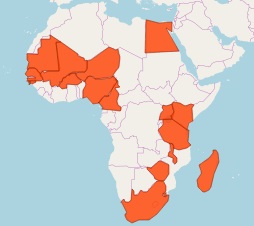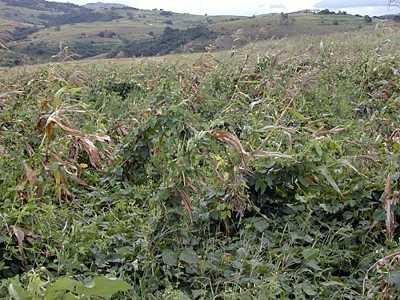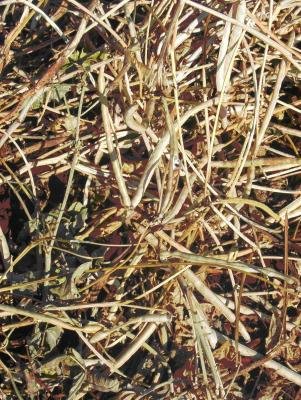Credits: Biovision-Infonet

(c) van Wik Ben-Erik, Courtesy of Ecoport (www.ecoport.org

(c) Roger P. Ellis, Courtesy of Ecoport (www.ecoport.org)

(c) A. Bruntse (Courtesy of Meru Herb Farmers)

(c) A. Bruntse (Courtesy of Meru Herb Farmers)
Scientific Name: Vigna unguiculata
Order / Family: Fabales: Fabaceae
Local Names: Kunde (Swahili, Kipsigis), Mathoroko (Kikuyu), Likhuvi (Luhya), alot-bo (Luo), Nthooko (Kamba), Egesare (Kisii), Kiyindiru (Luganda)Common Names: Yard long bean
Pests & Diseases: African bollworm , Anthracnose, Aphids, Bacterial blight, Brown blotch, Bugs , Charcoal rot, Cowpea mosaic diseases, Cowpea weevil, Cowpea wilt, Damping-off diseases, Flower or blister beetles, Leaf spots, Legume pod borer, Powdery mildew, Purple witchweed, Root-knot nematodes, Rust, Southern blight, Storage pests, Thrips
Other pests: Bean fly, Foliage beetles, Whiteflies
Geographical Distribution in Africa

General Information and Agronomic Aspects
Cowpeas are basically annual crops grown for their leaves and seed.
The growth habit is climbing, spreading or erect and they belong to the bean family (Leguminosae) (Papilionaceae). Cowpeas are native to Africa where they were domesticated over 4000 years ago.
The crop exhibits much variation in growth habit, leaf shape, flower colour and seed size and colour.
Cowpeas are mainly important in the marginal rainfall areas because they are well adapted to dry climate and suitable for a variety of intercropping systems.
Cowpeas are cultivated for the seeds (shelled green or dried), the pods or leaves that are consumed as green vegetables or for pasture, hay, silage and green manure.
Tender cowpea leaves and shoots contain 4% protein, 4% carbohydrates and are rich in calcium, phosphorus and vitamin B. Dried seeds contain 22% protein and 61% carbohydrates.
The leaves may be dried and stored for later use. Cowpeas that are sprayed with pesticides should not be eaten as leaves unless pre-harvest intervals are followed.
In Africa, where cowpeas are the preferred food legume, they are consumed in three basic forms:
- Cooked together with vegetables, spices and often palm oil, to produce a thick bean soup, which accompanies the staple food (cassava, yams, plantain)
- Decorticated and ground into a flour and mixed with chopped onions and spices and made into cakes that are either deep-fried (akara balls)
- Steamed (moin-moin)

(c) A. Bruntse (Courtesy of Meru Herb Farmers)
Climate conditions, soil and water management
Cowpeas are generally tolerant to drought and low light conditions, but are very susceptible to a variety of insects and diseases and do not do well in poorly drained and cool areas.
Local land races of cowpeas grown by farmers in West Africa are well adapted so that they start to flower at the end of the rains at a particular locality.
The optimum temperature to their growth and development is 20 to 35degC.
Cowpea can grow in a wide range of soils, well adapted to light sandy soils where most other crops produce poorly, and they do well on acid soils.
On heavy fertile soils they show a vigorous vegetative growth, but not necessarily a good grain yield.
Most varieties need a minimum rainfall of 200 mm during a growing season.
Propagation and planting
Cowpeas seeds are planted about 20 to 40 cm apart and are often grown as an intercrop with pearl millet, sorghum or maize at wide spacings (total plant population 10,000-20,000 plants per ha).
When produced as a green vegetable, they are commonly grown as a monocrop in rows 30 to 40 cm apart with 8 to 12 cm between plants. Some very drought resistant types may grow for two seasons in the farm.
Tillage normally follows the crop with which cowpeas are interplanted. When sown in rows the seed-rate is 10-40 kg/ha.
Cowpea Varieties and their Characteristics:
| Variety | Maturity Days | Target areas of production | Potential grain yield (t/ha) | Remarks |
| “Machakos 66” (M66) | 85-95 | Medium and higher altitudes 1200-1500 m above sea level | 1.5-1.8 | Dual purpose; creamy brown grains and good for intercropping; tolerant to cowpea yellow mosaic virus (CYMV) and scab; moderately tolerant to Septoria leaf spot and powdery mildew |
| “Katumani 80” (K80) | 75-85 | Drier areas or areas below 1500 m above sea level receiving less than 200 mm rain per season | 1.8-2.0 | Dual purpose; grains creamy brown; resistant to aphids; moderately tolerant to thrips, pod borers and leaf hoppers; susceptible to CYMV |
| “KVU 27-1” | 70-90 | 600 – 1200 m | 1.5-1.8 | Dual purpose; dark red grains; moderately tolerant to aphids, thrips, pod borers and leaf hoppers; moderately resistant to foliar fungal diseases and CYMV |
| “KVU-419” | 65-72 | Areas below 1200 m receiving less than 200 mm rain per season | 1.2-1.5 | Grain variety; smaller seed than both “M66” and “K80”; tolerant to cold and recovers very fast from drought |
| “KVU HB 48E 10” | 85-95 | Medium and higher altitudes 1200-1500 m above sea level | 1.2-1.4 | More vegetable type than grain type; tolerant to virus diseases |
| “KCP 022” | 60-75 | 0-1200 m | 1.2-1.5 | Drought tolerant |
| “MTW 63” | 60 | 1-1500 m | 2.5 | Pest tolerant |
| “MTW 610” | 60 | 1-1500 m | 2.5 | Large grains |
| “Kunde 1” | 75-90 | Below 2000 m | 1.2-2.5 | Dual purpose |
| “ICV” | 75 | 1-1500 m | 2.2 | Pest tolerant |
| “Ngombe” | Semi spreading, good for green leaf production, sweet taste of grain | |||
| Local varieties(land races) | 0.3-0.5 | Varying colours and spreading or semi spreading |
Examples of Cowpea varieties in Tanzania
- “Fahari” (altitude recommended: 0-1500 m; days to flowering: 50; grain yellowish brown; grain yield: 2.4 t/ha; resistant to CYMV
- “Tumaini” (altitude recommended: 0-1500 m; days to flowering: 48; grain cream; grain yield: 2.4 t/ha; resistant to CYMV and moderately resist to bacterial blight
- “Vuli 1” (altitude recommended: 0-1500 m; grain red; grain yield:1.8-2.0 t/ha; resistant to CYMV and moderately resist to bacterial blight
- “Vuli 2” (altitude recommended: below 1500 m; grain creamish white; grain yield: 2.0-2.5 t/ha; resistant to CYMV and bacterial blight; moderately susceptible to pests
Examples of Cowpea varieties in Uganda
- “Amul” (local variety: regions: eastern and northern districts of Uganda; yield potential; 0.5 t/ha)
- “Apei” (local variety: regions: eastern and northern districts of Uganda; yield potential; 0.5 t/ha)
- “Apio” (local variety: regions: eastern and northern districts of Uganda; yield potential; 0.5 t/ha)
- “Ebelat” (local variety: regions: eastern and northern districts of Uganda; yield potential; 0.5 t/ha)
- “Icinkukwa” (local variety: regions: eastern and northern districts of Uganda; yield potential; 0.5 t/ha)
- “Katumani 80” (as in Kenya)
- “Kisyanka” (local variety: regions: eastern and northern districts of Uganda; yield potential; 0.5 t/ha)
- “IT82D-522-1” (improved variety; yield potential: 4.5 t/ha)
- “IT85F-1987” (improved variety: yield potential: 2.1 t/ha)
Husbandry
Most cowpea crops are rain-fed, a few are irrigated and others use residual moisture in the soil after harvest of a rice crop. Cowpeas are particularly well suited for rice-based cropping systems.
Two to three weedings during the first 1.5 months after planting are recommended. Losses due to weeds can be 30-65%. Parasitic weeds, such as Striga gesnerioides (Purple withweed), generally associated with continuous cropping of cowpeas in Africa, may also cause severe damage.
One additional benefit of cultivating cowpeas is their ability to fix atmospheric nitrogen in root nodules through symbiosis with Rhizobium bacteria that are common in most soils.
An effective cowpea-Rhizobium symbiosis fixes more than 150 kg/ha of N and supplies 80-90% of the total N required. Inoculation may be advantageous, if the crop has not been grown for many years.
In general, no fertilisers are applied. Cowpeas are commonly incorporated in crop rotations in semi-arid, humid and subhumid environments.
A cowpea crop of the leafy types grown before a maize or millet crop and incorporated green into the soil, can produce a good grain crop without any addition of more nitrogen.
Intercropped cowpeas also share nitrogen with the other crops e.g. maize, millet, sorghum and cotton). For intercropping choose a cowpea variety carefully – the spreading types may over power other crops such as cotton by entangling their branches and interfering with fieldwork.
Cowpeas do not normally respond to nitrogen or phosphorus fertilisers, so none need adding. However where soils are highly eroded an application of 5 tons/ha of dry compost or manure is beneficial.
Weed during early stages of crop, later the cowpeas will cover the ground and suppress weeds including purple witchweeds.
Two weedings are recommended, one two weeks after emergence and the second weeding just before flowering.

(c) Roger P. Ellis, Courtesy of Ecoport (www.ecoport.org)
Harvesting
Leaves for eating must be young and tender. Three leaf pickings (starting 2 1/2 -3 weeks after planting at weekly intervals have little effect on grain yields of five to six 90 kg bags of seed per acre.
Green pods are harvested by hand when they are still immature and tender (12-15 days after flowering). When grown as a grain, harvesting is complicated by the prolonged and uneven ripening of many cultivars.
Time of harvesting is critical as mature pods easily shatter, so hand-picking can be advantageous. Sometimes plants are pulled when most of the pods are mature. For hay, the crop is cut when most of the pods are well developed.

(c) A. Bruntse (Courtesy of Meru Herb Farmers)
Uses
Food
Leaves and seeds widely used as food. Some communities grow cowpeas mainly as a vegetable (Luhya). Young leaves are often cooked with Potash. The vegetable may be cooked alone or with other vegetables, mainly Corchorus olitorius and C. trilocularis (mlenda). The leaves are cooked with Corchorus spp. Leaves, milk and butter added and served to breast feeding mothers (Luo). Leaves are normally eaten with ugali or mashed with maize and potatoes or other pulses (Kikuyu). The seeds may also be boiled and eaten alone (Luo) or mashed and butter added. Cowpea leaves may be dried and stored for several months. Cowpea is a major leafy vegetable among the Mijikenda, often mixed with leaves of sweet potato, cocoyam, pumpkin and Corchorus olitorius.
Fodder
It’s a good animal fodder, roots are reportedly very poisonous